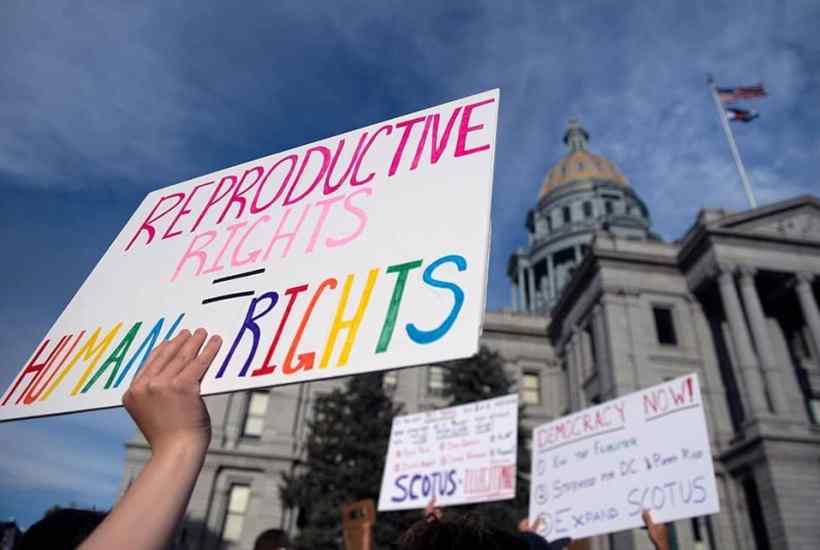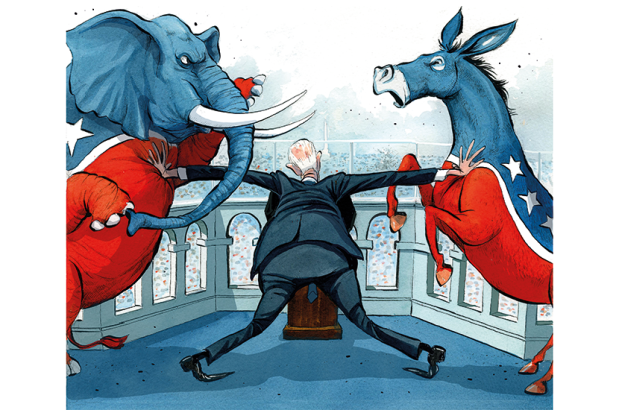The US Supreme Court has not banned abortion. The point made by its ruling – a pretty reasonable one – was that such issues should be decided by elected politicians, not by appointed judges. ‘It is time to heed the Constitution and return the issue of abortion to the people’s elected representatives,’ wrote Justice Samuel Alito in his majority opinion. In other words: stop confusing the job of the court with the job of the legislature. If you want to protect women’s rights in the United States, pass a law to do so.
But Congress has not passed such a law. As a result, millions of women are losing access to abortion services in states that have been waiting for Roe vs Wade to be overturned. In many cases, there are virtually no exceptions. A teenage rape victim will no longer be able to have an abortion in Kentucky. A victim of incest in Arkansas will need to cross state lines if she doesn’t want to go through with her pregnancy. For pro-choice Americans like me, there’s little comfort to be found in the Court’s nuanced ruling.
The only way to explain this gulf – between the ruling and what’s actually happening – is to explain what fills it: extreme, divisive politics. Power-hungry partisans have been inflaming the issue of abortion for almost 50 years – trading on vitriol for votes, and leaving large legislative gaps around women’s rights. It has suited both parties to use the Supreme Court to play politics. The question is whether they really want to stop.
‘You can have the final word,’ Joe Biden said in his speech from the White House last week. ‘My message to the American people: you have the power to elect leaders who will defend and protect your rights,’ echoed his vice-president Kamala Harris on Twitter. It’s as if they’ve forgotten who is in charge. What they mean to say is ‘vote Democrat’. The political usefulness of being able to talk about abortion leading up to the midterm elections in November – which were going to be dominated by inflation – seems to trump any other concern.
Barack Obama took to social media to brand the decision ‘devastating’, calling on people to ‘knock on doors’ and vote. Of course, as president he had the opportunity to pass a law protecting abortion rights when he first entered the Oval Office with a Democrat supermajority behind him. He said at the time that reproductive rights ‘weren’t a legislative priority’. He, too, could see its usefulness as an election tool. As did Donald Trump. As do they all.
But if Biden agrees these rights are a priority now, it may not take an election – or another Democrat supermajority – to fix this. There is majority support in America for access to abortion (including around 67 per cent support in the first trimester). And, whisper it, there could even be a majority in Congress. A breakthrough could be there, if Biden reaches for it.
Yes, Democrats held a vote on abortion in May, when the Supreme Court ruling was leaked. But that vote was symbolic, staged to fail: it was a radical piece of legislation that would have created loopholes enabling abortion throughout the full nine months of pregnancy. A few Democrats even joined Republicans in voting it down.
Behind the scenes, Republican senators Susan Collins from Maine and Lisa Murkowski from Alaska have been working on more narrow legislation to protect abortion rights. In statements on the ruling last week, several other Republican senators, including Shelley Moore Capito in West Virginia and Thom Tillis in North Carolina, released statements that suggest an openness to dialogue.
These numbers don’t take Biden to the 60 votes needed in the Senate to pass contentious legislation – but it’s getting there. Proposing federal legislation to guarantee access to abortion for, say, the first 12 weeks, with states able to legislate for a higher cap individually, makes the idea of negotiation at least feasible – and worth trying. It could be sold as a backstop protection for all American women seeking abortions, the vast majority of which happen in the first trimester.
This should be a tailor-made case for ‘moderate’ Joe. His pitch, after all, was to unify, to reach out and make common cause. Such language won him the nation’s support – including mine – in the 2020 election. A compromise of 12 weeks (putting US abortion laws on par with Germany) would no doubt upset many in the pro-life and pro-choice camps. But pursuing a more liberal policy on the federal level comes with its own vulnerabilities: the more partisan any abortion bill seems, the more at risk it is when the other party gets into office.
From the outset, Roe was considered a shaky ruling. Even former judge Ruth Bader Ginsburg, who notoriously leaned left on the court, thought Roe was bad law. She wanted to enshrine a woman’s right to abortion under the Constitution, yet noted as recently as 2013 that ‘Roe isn’t really about the woman’s choice.’
Her point expands past the technicalities of court rulings: since the 1973 decision on Roe vs Wade, women and their rights have come second to party politics. While other western countries, Britain included, were debating and settling questions around reproductive healthcare, US politicians were hiding under a judicial umbrella. They felt so protected by the Supreme Court’s decision that they adopted increasingly radical and often thoughtless positions on the issue, confident that they’d never be asked to act.
That protection disappeared last week: both for women and for the politicians who never bothered to codify abortion rights into law. America is long overdue a debate on how to settle this. The fear and panic in the air is not due to the Supreme Court ruling, but because it really now is down to the politicians to act.
Got something to add? Join the discussion and comment below.
Get 10 issues for just $10
Subscribe to The Spectator Australia today for the next 10 magazine issues, plus full online access, for just $10.
You might disagree with half of it, but you’ll enjoy reading all of it. Try your first month for free, then just $2 a week for the remainder of your first year.















Comments
Don't miss out
Join the conversation with other Spectator Australia readers. Subscribe to leave a comment.
SUBSCRIBEAlready a subscriber? Log in